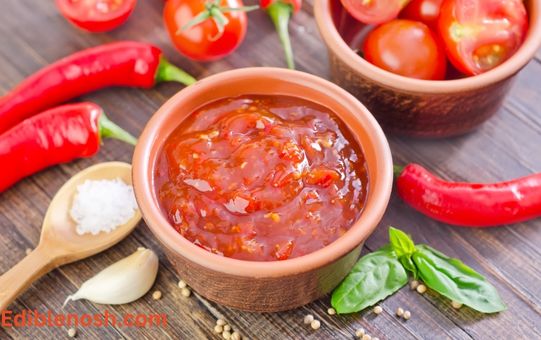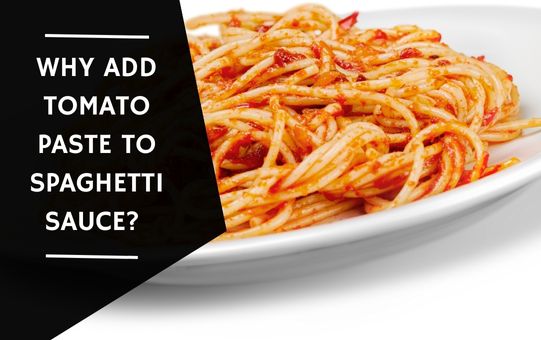It is a common Italian tradition to add tomato paste to spaghetti sauce. However, why add tomato paste to spaghetti sauce? What is the scientific basis for this seemingly simple action?
Spaghetti sauce is one of the world’s most iconic dishes. You may believe that there is nothing unique about it. However, there is a science behind the preparation of spaghetti sauce.
This article will examine five reasons why tomato paste is an indispensable ingredient in many spaghetti sauces.
Contents
Why Add Tomato Paste To Spaghetti Sauce Matter?
Tomato paste is a concentrated form of tomato that is commonly used in spaghetti sauce to add depth of flavor and richness to the dish. It is made by cooking tomatoes for several hours, reducing the moisture content, and concentrating the flavors.
Adding tomato paste to spaghetti sauce can enhance the overall taste and texture of the sauce, as it adds a thicker consistency and a slightly sweet and savory flavor.
In addition, tomato paste is a good source of umami, the fifth basic taste that enhances the savory flavor of foods. This is due to the presence of glutamate, an amino acid that is found in high levels in tomato paste.
Adding tomato paste to spaghetti sauce, it can help to balance the acidity of the tomatoes and other ingredients, creating a more complex and satisfying flavor profile.
Reasons to Add Tomato Paste to Spaghetti
Here are the five major reasons to add tomato paste to spaghetti:
1. Intensifies the Tomato Flavor
One of the primary reasons to add tomato paste to spaghetti sauce is to intensify the tomato flavor. Tomato paste is made from ripe tomatoes that have been cooked down and reduced to a thick, concentrated puree. This process concentrates the flavors and sugars of the tomatoes, resulting in a paste that is much more flavorful than fresh tomatoes.
When you add tomato paste to spaghetti sauce, you are essentially adding a concentrated burst of tomato flavor to the dish. This can help to balance out any other flavors in the sauce, such as garlic, onions, or herbs, and ensure that the tomato flavor remains prominent.
2. Deepens the Color
In addition to intensifying the tomato flavor, tomato paste can also deepen the color of your spaghetti sauce. Tomato paste is much darker in color than fresh tomatoes, and it can help to give your sauce a more vibrant, red hue.
This is particularly useful if you are using light-colored ingredients in your sauce, such as chicken broth or white wine, which can dilute the color of the sauce.
3. Adds Body and Thickness
Another reason to add tomato paste to spaghetti sauce is that it can help to add body and thickness to the dish. Tomato paste is a natural thickener, and it can help to give your sauce a more cohesive, velvety texture.
This is especially useful if you are using a broth-based sauce, as the tomato paste can help to bind the ingredients together and create a more robust, satisfying sauce.
4. Improves the Shelf Life
If you are planning on storing your spaghetti sauce in the refrigerator or freezer, adding tomato paste can be a great way to extend its shelf life. Tomato paste is a natural preservative, and it can help to prevent the growth of harmful bacteria in your sauce.
This can be especially useful if you are using fresh ingredients in your sauce, such as herbs or vegetables, which can spoil more quickly.
5. Enhances the Nutritional Value
Finally, adding tomato paste to your spaghetti sauce can also enhance its nutritional value. Tomato paste is rich in antioxidants, vitamins, and minerals, including lycopene, which is known for its potential health benefits.
Lycopene is a powerful antioxidant that has been linked to a reduced risk of heart disease, cancer, and other chronic conditions.
Read Also: Why Can’t I Eat Tomato Sauce?
How to Use Tomato Paste in Spaghetti Sauce?
Using tomato paste in spaghetti sauce is easy and can add depth, flavor, and richness to the dish. Here are a few simple steps to follow when incorporating tomato paste into your spaghetti sauce:
- Begin by heating a small amount of oil in a pan over medium heat. Add minced garlic and onions, and cook until the onions are translucent.
- Stir in a can of tomato paste, and cook for a minute or two until the paste begins to caramelize and deepen in color.
- Add any additional ingredients, such as diced tomatoes, herbs, and spices, and stir to combine.
- Pour in a cup or two of broth or water, and bring the sauce to a simmer.
- Reduce the heat to low, and let the sauce simmer for at least 20-30 minutes to allow the flavors to meld.
- Taste the sauce and adjust the seasoning as needed. You may want to add a splash of red wine, a pinch of sugar, or some additional herbs or spices to balance the flavors.
- Serve the sauce over cooked spaghetti noodles, and enjoy!
Alternatively, you can also add tomato paste to a store-bought spaghetti sauce to give it a boost of flavor and depth. Simply stir in a couple of tablespoons of tomato paste into the sauce, and heat until warmed through. Be sure to taste the sauce and adjust the seasoning as needed before serving.

Tips for Making the Best Spaghetti Sauce
There are many ways to make delicious spaghetti sauce, but here are a few tips to help you create the best possible version:
- Use fresh ingredients whenever possible. Fresh tomatoes, garlic, onions, and herbs will all add flavor and depth to your sauce. If you don’t have access to fresh ingredients, be sure to use high-quality canned or frozen alternatives.
- Cook the sauce slowly. Allowing your spaghetti sauce to simmer for at least 20-30 minutes will give the flavors time to meld and intensify. This is especially important if you are using fresh ingredients, as they may need more time to break down and release their flavors.
- Add a bit of sugar. A pinch of sugar can help to balance out the acidity of the tomatoes and create a more well-rounded sauce. Be sure to taste the sauce and adjust the amount of sugar as needed to achieve your desired level of sweetness.
- Experiment with different herbs and spices. Basil, oregano, thyme, and red pepper flakes are all common additions to spaghetti sauce, but feel free to mix and match different herbs and spices to create your own signature blend.
- Consider using tomato paste. Tomato paste is a concentrated tomato puree that can add flavor, depth, and thickness to your sauce. It is particularly useful for intensifying the tomato flavor and adding body to broth-based sauces.
- Don’t be afraid to add a splash of red wine. A splash of red wine can add depth and complexity to your sauce, and it pairs particularly well with tomato-based dishes. Just be sure to simmer the sauce for a few minutes after adding the wine to allow the alcohol to cook off.
By following these tips, you should be well on your way to making the best spaghetti sauce possible. Don’t be afraid to experiment and try new ingredients and techniques to find the perfect combination for your tastes.
Read Also: Why Add Butter To Tomato Sauce?
Conclusion
There are many reasons why tomato paste is an essential ingredient in many spaghetti sauces. It intensifies the tomato flavor, deepens the color, adds body and thickness, improves the shelf life, and enhances the nutritional value of the dish.
Whether you are making spaghetti sauce from scratch or using a store-bought jar, be sure to include tomato paste as a key ingredient for the best possible results.
FAQs | Add tomato sauce to Spaghetti
Here are a few FAQS related to adding tomato paste to spaghetti:
What does tomato paste do to spaghetti sauce?
Tomato paste intensifies the tomato flavor, deepens the color, adds body and thickness, improves the shelf life, and enhances the nutritional value of spaghetti sauce.
It is a concentrated form of tomato puree that is made by cooking down and reducing ripe tomatoes to a thick puree.
How much tomato paste should I add to the spaghetti sauce?
The amount of tomato paste you should add to spaghetti sauce will depend on your personal taste and the recipe you are using.
As a general rule, a small can (6 ounces) of tomato paste is sufficient for most spaghetti sauces that serve 4-6 people. You can always start with a smaller amount and add more to taste.
Can I use tomato sauce instead of tomato paste in spaghetti sauce?
Technically, you can use tomato sauce instead of tomato paste in spaghetti sauce, but the results may not be quite the same.
Tomato sauce is generally thinner and less concentrated than tomato paste, so it may not provide the same depth of flavor or thickness to the sauce. If you do use tomato sauce, you may need to adjust the other ingredients in the recipe accordingly.
Can I omit the tomato paste from my spaghetti sauce recipe?
If you don’t have tomato paste on hand or you prefer a lighter-tasting sauce, you can omit the tomato paste from your spaghetti sauce recipe.
However, keep in mind that the sauce may lack some of the depth of flavor and thickness that tomato paste can provide. You may need to compensate by using additional canned tomatoes or a thicker broth to achieve the desired consistency.
How do I store leftover spaghetti sauce with tomato paste?
To store leftover spaghetti sauce with tomato paste, transfer it to an airtight container and refrigerate for up to 4 days.
Alternatively, you can also freeze the sauce for up to 3 months. When you are ready to use the sauce, thaw it in the refrigerator or microwave and heat it on the stove until warmed through. Be sure to stir the sauce well before serving to distribute the tomato paste evenly.

